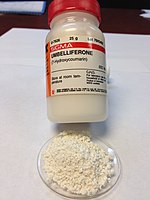This article needs additional citations for verification. (March 2020) |

| |

| |
| Names | |
|---|---|
| Preferred IUPAC name
7-Hydroxy-2H-1-benzopyran-2-one | |
| Other names
7-hydroxycoumarin, hydrangine, skimmetine, beta-umbelliferone
| |
| Identifiers | |
3D model (JSmol)
|
|
| ChEBI | |
| ChEMBL | |
| ChemSpider | |
| ECHA InfoCard | 100.002.038 |
PubChem CID
|
|
| UNII | |
CompTox Dashboard (EPA)
|
|
| |
| |
| Properties | |
| C9H6O3 | |
| Molar mass | 162.14 g/mol |
| Appearance | yellowish-white crystalline odorless powder |
| Melting point | 230 °C (446 °F; 503 K) (decomposes) |
| -88.22·10−6 cm3/mol | |
Except where otherwise noted, data are given for materials in their standard state (at 25 °C [77 °F], 100 kPa).
| |
Umbelliferone, also known as 7-hydroxycoumarin, hydrangine, skimmetine, and beta-umbelliferone, is a natural product of the coumarin family.
It absorbs ultraviolet light strongly at several wavelengths. There are some indications that this chemical is antimutagenic,[1] it is used in sunscreens.[2] Umbelliferone has been reported to have antioxidant properties.[3][4]
It is a yellowish-white crystalline solid that has a slight solubility in hot water, but high solubility in ethanol.
- ^ Ohta T, Watanabe K, Moriya M, Shirasu Y, Kada T (1983). "Anti-mutagenic effects of coumarin and umbelliferone on mutagenesis induced by 4-nitroquinoline 1-oxide or UV irradiation in e. Coli". Mutation Research. 117 (1–2): 135–138. doi:10.1016/0165-1218(83)90160-x. PMID 6403855.
- ^ Du L (2008). "Rational design of a fluorescent hydrogen peroxide probe based on the umbelliferone fluorophore". Tetrahedron Letters. 49 (19): 3045–3048. doi:10.1016/j.tetlet.2008.03.063. PMC 2490821. PMID 19081820.
- ^ "UMBELLIFERONE". www.chemicalland21.com. Retrieved 21 November 2011.
- ^ Sim MO, Lee HI, Ham JR, Seo KI, Kim MJ, Lee MK (2015). "Anti-inflammatory and antioxidant effects of umbelliferone in chronic alcohol-fed rats". Nutr Res Pract. 9 (4): 364–369. doi:10.4162/nrp.2015.9.4.364. PMC 4523479. PMID 26244074.